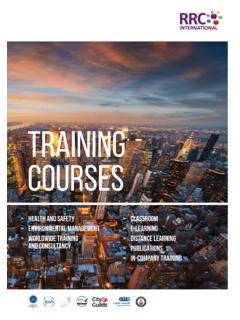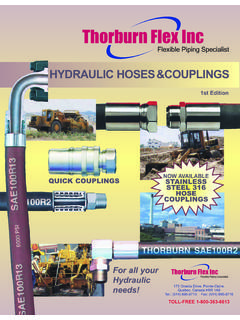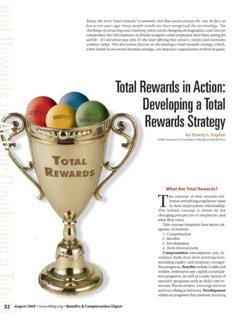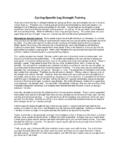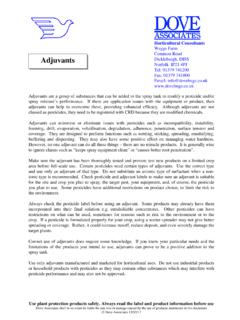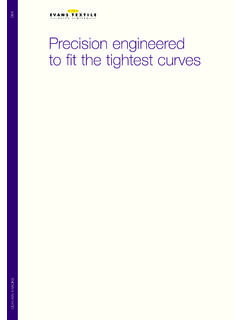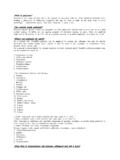Transcription of NEBOSH International General Certificate UNIT IGC1
1 NEBOSH International General CertificateUNIT igc1 MANAGEMENT OF International HEALTH & SAFETYELEMENT 4: HEALTH ANd SAFETY MANAGEMENT SYSTEMS 3 - PLANNINGSAMPLE MATERIAL(Material correct Autumn 2013)RRC 27-37 St George s Road London SW19 4dS United KingdomT +44 (0)20 8944 3100 F +44 (0)20 8944 7099 Skype Id rrctrainingElement 4: Health and Safety Management Systems 3 - PlanningUnit igc1 Element 4 | 4-6 RRC Training Risk assessment is the formalised process of identifying hazards, evaluating risk and then either eliminating or controlling that risk to an acceptable level. A hazard is something with the potential to cause harm. Risk is the likelihood that a hazard will cause harm in combination with the severity of injury, damage or loss that might foreseeably occur. The main objective of risk assessment is the prevention of accidents and ill-health. There are five steps to risk assessment:1. Identify the Identify the people who might be harmed and Evaluate the risk and decide on Record the significant findings and implement Review and update as necessary.
2 Hazards can be identified using various methods such as task analysis, legislation, manufacturers information and incident data. Workers, contractors, visitors and members of the public must all be considered in the risk assessment process. Risk can be scored or rated using a simple Risk = Likelihood x Severity calculation where likelihood and severity are allocated numbers on a scale. If the risk is unacceptable then controls must be introduced to either eliminate hazards or create a safe place or a safe person. Any residual risk must be acceptable. Legal standards can often be used to indicate what level of risk is acceptable. Assessments must be reviewed on significant change, after an incident and perhaps periodically. Sometimes it is necessary to focus risk assessment on a vulnerable person or group of workers such as young persons, expectant women and nursing mothers, disabled workers and lone and Practice of Risk AssessmentLegal RequirementsILO Convention C155, Article 15, imposes a duty to ensure that a workplace is, so far as is reasonably practicable, without risk to employees.
3 This has long been accepted to imply the need for risk assessment, as the concept of reasonable practicability requires the evaluation of the cost (in time, effort and money) versus the risk of harm. We will consider the meaning of the term risk in the next DefinitionsHazardSomething with the potential to cause SAMPLE MATERIALE lement 4: Health and Safety Management Systems 3 - Planning RRC Training unit igc1 Element 4 | 4-7 Hazards can be broadly classified as physical ( electricity), chemical ( mercury), biological ( hepatitis), ergonomic ( very repetitive handling) and psychological ( stress).Note that a hazard is the something that causes the harm. If an office worker receives an electric shock from an item of electrical equipment that has a damaged flex, then electricity is the hazard, not the damaged flex. It is electricity that causes the harm; the damaged flex is the failure in the controls or preventive measures. If the flex were not damaged then the hazard would still be present (electricity is still running through the equipment) but it would be properly controlled and the electric shock would not likelihood that a hazard will cause harm in combination with the severity of injury, damage or loss that might foreseeably can be described qualitatively using words such as high , medium or low.
4 There will always be a degree of subjectivity to this qualitative description since the words represent one person s opinion of the risk level. Different individuals have very different personality characteristics and so two people may disagree on the level of risk inherent in a can also be defined quantitatively using probabilities and/or frequencies that have been derived from hard data. This type of quantified risk assessment is far more rigorous than qualitative risk assessment and is beyond the scope of this assessmentA formalised process of identifying hazards, assessing the risk that they generate and then either eliminating or controlling the assessment is a process that people do automatically all the time. When you cross the road you carry out a risk assessment; when you drive a car you carry out a risk assessment; when you boil a kettle you carry out a risk assessment. But, of course, this assessment is normally done very quickly and without conscious thought or effort.
5 If you are not very good at this process then you will not live long. There are occasions in normal life, however, when you might become more aware that you are assessing risks. If you look after very young children you will consciously think about the particular hazards that present a risk to a child. If you start to take part in certain sports or activities such as rock climbing or scuba diving, you will start to assess risks in your conscious mind rather than doing it automatically. A workplace risk assessment is simply an extension of this automatic self-preservation mechanism. Objectives of Risk AssessmentThe aim of risk assessment is to ensure that hazards are eliminated or risks minimised by the correct application of relevant objectives of risk assessment are to prevent: Death and personal injury. Other types of loss incident. The occurrence of breaches of statute law which might lead to enforcement action and/or prosecution. The direct and indirect costs that follow on from objectives relate directly to the moral, legal and economic arguments we discussed in Element Types of IncidentA failure to adequately assess risk in the workplace will lead to incidents, which can be categorised into various different types depending on outcome: Accident An unplanned, unwanted event which leads to injury, damage or loss.
6 An accident is unplanned. Any deliberate attempt to cause injury or loss is therefore not an accident. Injury accident an unplanned, unwanted event which leads to personal injury of some sort, a worker on the ground is struck on the head and killed by a brick dropped by another worker on a 5 m high scaffold. Damage only accident an unplanned, unwanted event which leads to damage to equipment or property, a lorry driver misjudges the turning circle of his vehicle and knocks over a barrier at the edge of a site entrance, crushing the barrier beyond repair. Near miss an unplanned, unwanted event that had the potential to lead to injury, damage or loss (but did not, in fact, do so), a worker drops a spanner from a scaffold narrowly missing a pedestrian, but no injury or harm was SAMPLE MATERIALE lement 4: Health and Safety Management Systems 3 - PlanningUnit igc1 Element 4 | 4-8 RRC Training Dangerous occurrence a specified event that has to be reported to the relevant authority by statute l aw.
7 Ill-health incident an unplanned, unwanted event which leads to ill-health of some RatiosAccident ratios (often referred to as accident triangles) display the relationship between numbers of accidents with different outcomes. Research shows that this relationship forms a triangle, with the most serious outcomes being the least numerous (at the top) and those with proportionally higher numbers but less serious results forming the base. There are a number of different triangles used to display these relationships; one proposed by Bird is given in the figure Bird Accident TriangleRRC SAMPLE MATERIALE lement 4: Health and Safety Management Systems 3 - Planning RRC Training unit igc1 Element 4 | 4-9 The important message of the accident triangle is that serious outcome accidents tend to happen rarely and randomly. They are notoriously difficult to predict (if they were not, it would be easy to prevent them from happening). Near misses/incidents, on the other hand, happen far more frequently (600 times more frequently according to Bird).
8 Many near misses will be minor events of little or no consequence; if they happen again there would be no serious outcome. But some near misses will have the potential for very serious injury. These near misses should be thoroughly investigated and preventive measures put in place. In this way a serious outcome incident is prevented. You can also see that as near-miss events form the bottom of the triangle they form the greatest proportion of incidents by taking action to understand this large body of data deficiencies in the safety management system can be identified and more serious outcomes that accident ratio studies are based on statistical ratios. They cannot be used to predict exactly when a certain type of event might occur. For example, just because an organisation has had 600 near misses/incidents reported does not mean that the very next type of event will be a serious injury accident. That is an over-simplification of the accident Risk AssessorsRisk assessments should be carried out by competent people.
9 In this context the word competent would mean people who have sufficient training, knowledge, experience and other abilities. The exact training, knowledge and experience required will vary depending on circumstances. In some instances simply an ability to identify, read and correctly interpret guidance on a topic is sufficient. In others, a detailed understanding of background knowledge is essential to be able to correctly evaluate risk assessment might be carried out by one person. This is not ideal in many instances since it relies on one person s opinion and judgment. Ideally risk assessment will be carried out by a team. This allows for various views and opinions to be taken into account and so may result in a more successful assessment. The composition of a risk assessment team is not dictated, but might include: Workers familiar with the tasks and areas to be assessed. Health and safety specialists, such as safety practitioners and occupational health nurses.
10 Technical specialists, such as mechanical and electrical engineers. Line managers responsible for the tasks or areas being assessed. Worker safety size and composition of the team will vary depending on the nature of the workplace and the complexity of the risk assessment process being used. Note that it is not necessary for all members of the team to be competent in the risk assessment process, simply for some or one of the team members to be a competent person. The involvement of non-competent persons is useful for a number of reasons: Those team members may identify hazards and risks that might otherwise be missed (two pairs of eyes are better than one). They may ask questions and propose solutions that might otherwise not be considered. It allows experience to be safely gained in the practice of risk assessment. It facilitates employee awareness, involvement and consultation and so enhances the safety For a Suitable and Sufficient AssessmentA risk assessment should be suitable and sufficient.

